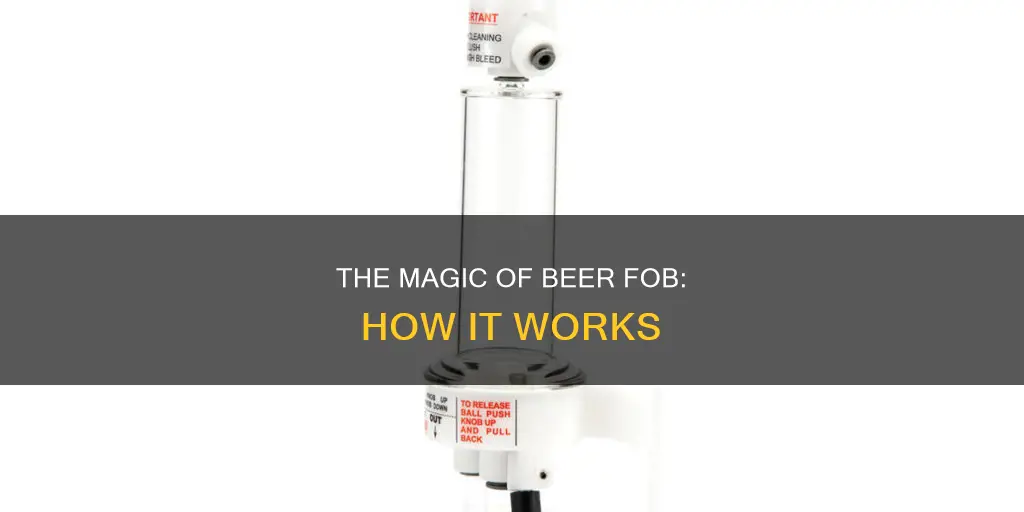
FOBs, or Foam On Beer Detectors, are used to prevent beer waste and increase beer profits. When a keg empties, a FOB is used to stop the beer flow immediately, keeping the lines full of beer and preventing them from filling with foam. This eliminates the need to refill the lines and purge the system with beer when tapping a new keg. FOBs are installed in long draw draft beer systems and work using a simple float valve. When beer is flowing, the float is lifted, allowing beer to pass through to the faucet. When the keg empties, the float drops down, stopping the beer flow and acting as a plug to prevent air or gas from entering the beer lines.
| Characteristics | Values |
|---|---|
| Full Name | Foam On Beer Detectors (FOBs) |
| Other Names | Profit Maximizers™, Froth-On-Beer (FOBs) |
| Function | Detect froth or gas in pressurized dispense systems |
| Origin | UK and Ireland in the 1970s |
| Installation | Installed on every keg in a pressurized dispense system, ideally where the keg is located at a distance in excess of 5 meters away from the dispense faucet |
| Action | Detects dispense gas that is propelling the draught product from the keg to the dispense faucet; shuts off the supply line from the keg to the dispense tap when the keg is empty |
| Benefits | Prevents beer waste, increases profits, saves time, reduces CO2 or Beer Gas usage, maintains cleaner supply lines, inhibits bacterial growth |
What You'll Learn

FOBs are float valves
FOBs, or Foam On Beer Detectors, are profit maximizers that work by reducing beer waste. When installed in a long-draw draft beer system, they prevent the beer lines from filling with foam when a keg empties, keeping the lines full of beer instead. This eliminates the need to refill and purge the system with beer when tapping a new keg, thereby significantly reducing waste.
To tap a new keg, the FOB must be reset by pushing the vent mechanism to release the gas/foam from the chamber. This allows the beer to flow from the keg into the chamber, lifting the float and enabling beer to flow to the faucet.
Like any other beer line, FOBs must be regularly cleaned and maintained. They are equipped with a float-lifting device, which lifts the float off the beer outlet hole, allowing cleaning fluids to enter and exit the FOB detector.
Antibiotics and Beer: A Safe Mix?
You may want to see also

They detect foam/gas in pressurised dispense systems
FOBs, or Foam On Beer Detectors, are in-line float valves that detect foam or gas in pressurised dispense systems. They originated in the UK and Ireland in the 1970s as a solution to the problem of wasted beer when a keg runs out and is changed.
A FOB should be installed on every keg in a pressurised dispense system, ideally where the keg is located more than 5 metres away from the dispense faucet. When a keg empties, the dispense gas travels through the keg and into the in-line FOB. As the liquid level in the FOB reduces, the float drops and shuts off the supply line from the keg to the tap, preventing air or gas from entering the beer lines. This maintains the line full of beer, rather than foam, and eliminates waste.
When a new keg is tapped, the trapped gas is vented off at the FOB, and the float is lifted, allowing the system to be re-pressurised and beer to be poured again. This process also prevents the wasting of dispense gas, which is particularly important in mixed gas systems where gas costs are higher.
FOBs also offer hygienic benefits by maintaining a full beer line at all times, inhibiting the opportunity for bacterial growth.
Beer's Blood-Thinning Effect: Myth or Reality?
You may want to see also

FOBs prevent beer waste
FOBs, or Foam On Beer Detectors, are an effective way to prevent beer waste and increase profits for bars and restaurants. When a keg is emptied without a FOB installed, the tap will spray and spit foam, leading to wasted beer and money, as well as additional costs for labour and cleanup. FOBs solve this issue by detecting when a keg is empty and immediately stopping the beer flow, ensuring the line remains full of beer instead of filling with foam.
By preventing foam from entering the system, FOBs eliminate the need to refill lines or purge the system when tapping a new keg. This significantly reduces beer waste, with some sources claiming savings of up to 75 ounces (almost 4 pints) of beer per keg. This reduction in waste translates directly into increased profits for establishments, making FOBs a valuable investment.
The engineering behind FOBs is quite simple. They are typically in-line float valves that detect the presence of draught dispense gas in a pressurized dispense system. When a keg empties, the float drops, creating a seal that prevents air or gas from entering the beer lines. This mechanism ensures that only solid beer packs the lines, preventing foam from entering the system until a new keg is tapped.
In addition to reducing beer waste, FOBs offer other benefits such as reducing the amount of CO2 or beer gas used and inhibiting bacterial growth in the supply lines. FOBs also save time for bartenders, as they no longer need to clear supply lines of gas and foam when changing kegs. With FOBs, establishments can maximize the profitability of each keg of draught product sold, making them a valuable tool in the hospitality industry.
Beer Butt Chicken: Does It Work?
You may want to see also

They save time and money
FOBs, or Foam-On-Beer detectors, are an essential investment for any bar or pub owner serving draught beer. They save time and money by reducing beer wastage and increasing profits.
When a keg empties without a FOB installed, the beer line fills with foam, and this beer is wasted. FOBs prevent this by stopping the beer flow as soon as the keg empties, keeping the lines full of beer instead of foam. This eliminates the need to refill the lines and purge the system when tapping a new keg, saving time and money. On average, a bar owner can save a minimum of four pints per keg, with even greater savings in venues with longer supply lines, such as stadiums, airports, and hotels.
The time and cost savings are further enhanced by the speed and ease of changing kegs with a FOB installed. The supply lines do not need to be cleared of gas and foam, allowing bartenders to change kegs more quickly and servers to receive their orders faster. This efficiency is particularly beneficial in busy venues with high beer turnover.
Additionally, FOBs reduce the amount of CO2 or beer gas used, as it no longer fills the supply line and escapes through the tap. This not only saves money on gas costs but also reduces the environmental impact of the bar or pub.
With FOBs, bar and pub owners can maximize the profitability of each keg, as there is no waste associated with pressurized draught dispense systems. By eliminating beer wastage, FOBs ensure that every drop of beer in the keg can be sold, increasing revenue and reducing costs.
Beer Coolers: Understanding the Science of Cold
You may want to see also

FOBs need regular cleaning
FOBs, or Foam On Beer Detectors, are an essential component of any long-draw draft beer system, helping to reduce beer waste and increase profits. However, to ensure their optimal functioning and maintain beer quality, FOBs need regular cleaning and maintenance.
Beer lines and FOBs are susceptible to the buildup of organic waste, minerals, and other contaminants over time. This accumulation can compromise the taste and quality of the beer, leading to dissatisfied customers and a negative impact on your establishment's reputation. Therefore, it is crucial to implement a consistent cleaning regimen for your FOBs.
The cleaning process for FOBs is straightforward and should be performed with the same diligence as cleaning beer lines. First, the FOB is equipped with a float-lifting device that raises the float, allowing cleaning fluids to enter and exit the FOB detector. Under no circumstances should the FOB be bypassed during cleaning. The cleaning fluids should be left to soak for an adequate amount of time, typically around 20 minutes, to ensure the effective removal of contaminants.
To achieve a thorough clean, it is recommended to use a combination of cleaning solutions. A beer line cleaner is effective at removing organic waste, while an acid beer line cleaner is ideal for tackling any mineral deposits or beer stones that may have accumulated. By alternating between these cleaning solutions, you can ensure that your FOBs are thoroughly sanitized.
The frequency of FOB cleaning is essential to maintain optimal beer quality. The Brewers Association recommends disassembling and cleaning FOB detectors every three months using a suitable cleaning solution. However, for the best results, it is advisable to clean your FOBs as regularly as you clean your beer lines. Industry standards suggest that beer lines should be cleaned every two weeks to prevent the buildup of yeast, mold, beer stone, and bacteria, which can adversely affect the taste of the beer.
Do LCBO Gift Cards Work at Beer Store?
You may want to see also
Frequently asked questions
FOB stands for Foam On Beer.
A FOB prevents foam from entering the beer line when a keg is empty, reducing beer wastage and increasing profits.
A FOB is a simple float valve. When beer is flowing, the float is lifted up and allows the beer to pass through to the faucet. When the keg is empty, the float drops down and closes the line.
A FOB is installed on a long draw beer system or long beer lines, commonly found in bars, pubs, stadiums, airports, and hotels.
By installing a FOB, you can save time and money on beer costs, improve beer taste, and reduce labour costs associated with cleaning up foam and changing kegs.







